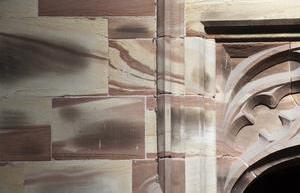£1.3 million funding to help our historic churches
The Churches Conservation Trust is one of 445 heritage organisations across the country set to receive a lifesaving financial boost from the Government thanks to the £1.57 billion Culture Recovery Fund to help them through the coronavirus pandemic.
This vital funding is from the Culture Recovery Fund for Heritage and the Heritage Stimulus Fund - funded by Government and administered at arms length by Historic England and the National Lottery Heritage Fund. Both funds are part of the Government’s £1.57 billion Culture Recovery Fund which is designed to secure the future of Britain’s museums, galleries, theatres, independent cinemas, heritage sites and music venues with emergency grants and loans.
Culture Secretary Oliver Dowden said: “As a nation it is essential that we preserve our heritage and celebrate and learn from our past. This massive support package will protect our shared heritage for future generations, save jobs and help us prepare for a cultural bounceback post covid.”
Peter Aiers, Chief Executive, CCT, said: “We are extremely grateful to Historic England and the Government for this funding, which will allow us to undertake repairs and conservation at 18 of our most in-need historic churches. The Churches Conservation Trust, like many charities, has suffered financially because of the Coronavirus pandemic and we face a significant fundraising gap due to having had to close churches. This award will help us to continue saving these beautiful historic buildings, to keep them open for the public as well as supporting vital craft skills in the heritage sector.”
Duncan Wilson, Historic England’s Chief Executive said: “It is heartening to see grants, both large and small, from the Government’s Culture Recovery Fund helping heritage sites and organisations across the country which have been hit hard by the effects of Covid-19. These grants range from giving skilled craft workers the chance to keep their trades alive to helping heritage organisations pay the bills, and to kick-starting repair works at our best-loved historic sites. The funding is an essential lifeline for our heritage and the people who work tirelessly to conserve it for us all, so that we can hand it on to future generations.”
The 18 churches in receipt of the £1,345,049 grant are located across England and projects vary in size and scope:
Bungay, St Mary, Suffolk: St Mary’s is a landmark for miles around and the focal point of the market town of Bungay. The 15th century tower, with its tall pinnacles and the intricate stone tracery of the west window are in need of extensive urgent masonry repairs. Thanks to this grant, St Mary’s, which is part of the adjoining ruined Benedictine priory, will continue to be an active and vibrant community building in the heart of this historic Suffolk town.

Christ Church, Waterloo in Merseyside: Christ Church has a thriving Friends group, hosting a wide variety of activities which welcome over 40,000 visitors per year. Lockdown reduced all income to zero and only a few activities are just now restarting. This grant will allow the re-leading of the fine Shrigley and Hunt stained glass and urgent stone repairs to the west window. These specialist glazing and stone repairs, using traditional skills, will help sustain historic craft skills.
Shrewsbury St Mary: Shrewsbury is a large much visited church needing high-level repairs, mainly to the pinnacles which are becoming increasingly dangerous. The vestry roof is sheeted following a lead theft so this project would look to recover this roof and stabilise the pinnacles along with associated high level masonry repairs.
Norwich St Augustine: High level masonry repairs are urgently needed at this medieval city church, which has also suffered from vandal damage to its rainwater goods. Vital funds will ensure the church can be offered for greater community use.
Saltfleeby All Saints, Lincolnshire: Saltfleetby’s chancel arch desperately needs stabilising to prevent its collapse. Work was to have started in March 2020, but the lockdown prevented it and since then our income has fallen dramatically putting the repairs on indefinite hold. Although the surrounding hamlet is tiny, we have a dedicated volunteer nearby who gives tours and talks with around 3000 visitors per annum.
Bristol St Paul: Rope access is needed for high level inspection and masonry repairs and vestry and apse roof repairs.

Evesham St Lawrence: Following the 2017 condition survey and a major fall of stone in 2018, a rope access inspection determined that major repairs to tower and spire stonework at high level were needed. The church is in a pedestrian precinct adjacent to the main high street which makes these repairs very urgent.
Parson Drove St John, Cambridgeshire: Urgent repairs to rainwater goods and roof covering are needed to stop water ingress. Improvements to drainage are also required. COVID-19 has stopped all local school visits and fundraising has been severely impacted.
Bristol St John: A lead theft has left Bristol St John's with only a temporary plastic and batten roof covering above the archway that Elizabeth I rode through on horseback to Bristol Old City through the town walls. A more permanent roof is urgently needed.
Langport All Saints, Somerset: Poor design of the south porch and rainwater goods and bad drainage has led to plaster damage, staining and flooding of the boiler room. The works are to identify and clear the below ground drainage, alter the RWG and minimise water ingress to the church.
South Elmham All Saints, Suffolk: With its distinctive Suffolk round tower, All Saints is an idyllic rural church which has suffered from structural movement in recent years. Structural investigations and repairs to masonry are needed to stabilize its ancient structure.
East Bradenham St Mary, Norfolk: The repair project for Grade I listed St Mary's Church consists of the reinstatement of lead covering to south aisle roofs, repairs to flashings, copings and rainwater goods. Following two consecutive lead thefts (2014; 2015) St Mary's is now in desperate need of a new roof covering. Due to lack of funding, for over six years the south aisle has been under temporary sheeting, which cannot longer ensure weather tightness. The repairs are of the utmost urgency because of the imminent risk of water ingress and further timber decay.
Farndish St Michael, Bedfordshire: The small rural church of St Michael is a peaceful retreat. Its C12th ancient fabric is under threat. Following a lead theft nearly six years ago, the reinstatement of a permanent roof covering and masonry repairs is now urgently needed.
Swingfield St Peter, Kent: A comprehensive programme of masonry repairs to the imposing St Peter’s tower will ensure the integrity of its ancient fabric, preventing the damaging effects of water penetration through open joints and stone saturation.
Ellough All Saints, Suffolk: This C 14th rural church with its elegant interior will be preserved by carrying out the urgent and essential repairs to the rainwater goods and roof timber fascias.
Aldwincle All Saints Northamptonshire: Remove temporary plastic sheeting and reinstate copper covering, including timber repairs and new cover flashings are to be fitted. Programme of works to rainwater goods and drainage, repairs to structural cracks and re-pointing. Internally, careful inspection and consolidation to ancient plasterwork.
Akenham St Mary Suffolk: Essential roof overhaul to stop water penetration that has begun at multiple points, including relaying lead valley gutter.
Saundby St Martin Nottinghamshire: Saundby’s slate roof has reached the end of its useful life, the underlying boards and battens are so rotten in places that even temporary patching is becoming impossible, risking water ingress and falling slates. This project would see the re-roofing of the church and undertake high level masonry.
445 organisations in total will receive a share of £67 million from the Culture Recovery Fund for Heritage to help with costs for operating, reopening and recovery. This includes famous heritage sites across the country, from Wentworth Woodhouse in Yorkshire to Blackpool’s Winter Gardens, Blyth Tall Ship to the Severn Valley Railway, the International Bomber Command Centre in Lincolnshire to the Piecehall in Halifax. The funds will save sites that are a source of pride for communities across the country.
12 organisations, including English Heritage, Landmark Trust, Historic Royal Palaces and the Canal and River Trust, will receive £34 million from the Heritage Stimulus Fund to restart construction and maintenance on cherished heritage sites to preserve visitor attractions and protect livelihoods for some of the most vulnerable heritage specialists and contractors in the sector.
The Architectural Heritage Fund (AHF) has also been awarded a grant from the Culture Recovery Fund through Historic England. The AHF will use the funding to support charities and social enterprises occupying historic buildings to develop new business plans and strategies for organisations affected by the pandemic.

